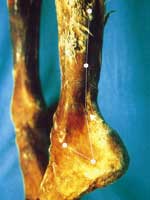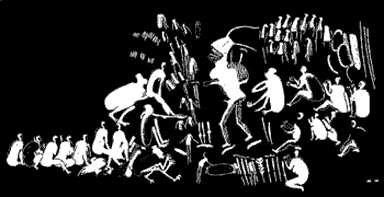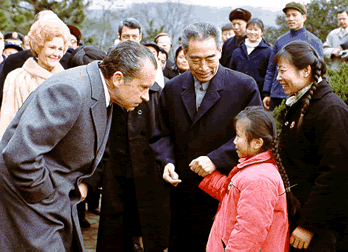History of Acupuncture
ICE AGE TATTOOS
 
A 5000-year-old mummified man found in the Alps had tattoos on his body which corresponded to traditional acupuncture points.
In 1991, a 5,000-year-old mummified man was found in the mountains along the border between Austria and Italy. Named Otzi after the Otz valley in which it was discovered, the mummy's body was remarkably well preserved, as were most of his clothing, tools and weapons. Scientists discovered a complicated system of bluish-black tattoos running along Otzi's back, right knee and left ankle. These tattoos were located directly on or within six millimeters of, traditional acupuncture points and meridians.
X-rays of the ice man's body revealed evidence of arthritis in the hip joints, knees, ankles and lumbar spine. Nine of the mummy's 15 tattoos are located on an acupuncture meridian commonly associated with treating back pain. In fact, one of the mummy's two cross-shaped tattoos is located near the left ankle on an acupuncture point (UB60) which is considered by several texts a "master point for back pain."
Autopsy also revealed that his intestines were filled with whipworm eggs, which can cause severe abdominal pain. Five other tattoos located on the body corresponded with points located on the gall bladder, spleen and liver meridians -- points that are traditionally used to treat stomach disorders.
"Taken together," the scientists added, "the tattoos could be viewed as a medical report from the stone age, or possibly as a guide to self-treatment marking where to puncture when pains occur."
"The locations of the tattoos are similar to points used for specific disease states in the traditional Chinese and modern acupuncture treatment," the scientists concluded. "This raises the possibility of acupuncture having originated in the Eurasian continent at least 2000 years earlier than previously recognized."
"At the time when Otzi was around, I'm sure that many shamanistic cultures worldwide might have practiced it," added Dr. Moser. "But only the Chinese formalized it and saved it into modern times."
ANCIENT SHAMEN

South African rock art depicting a Bantu shaman.
Early forms of acupuncture which probably arose during the Stone Age have survived in many parts of the world right down to present day. There is evidence that acupuncture has been practiced in ancient Egypt, Persia, India, Sri Lanka, many parts of Europe and South America, and even by the North American Indians. The Eskimos, for instance are still using sharpened stones for treating illness. The Bantus of South Africa scratch certain areas of their skin to allay the symptoms of many illnesses, while in Brazil there is a tribe whose method of treating illness is to shoot tiny arrows from a blowpipe on to specific areas of the skin. The practice of cauterizing a part of the ear with a hot metal probe has also been reported among certain tribes in Arabia. This is probably a vestige of the acupuncture practiced in ancient Egypt and Saudi Arab. The Ebers papyrus of 1550 B.C. (now in the British Musemum) describes a system of channels and vessels in the body which approximates more closely to the Chinese system of channels than to any known system of blood vessels, lymph vessels or nerves.
In India, an ayurvedic form of early acupuncture also existed. Ayurvedic acupuncture was practised by many in India and was taught as an Ayurvedic subject in the major ancient universities like Nalanda and Takshashila. Excavations have unearthed metal acupuncture needles in the sites of these ancient universities. The famous physician of India, Giba [Jivaka] is said in one of the texts such as the Chikitsa Vidya to have been born with an acupuncture needle in the right hand and a drug container in the left hand in about the 5th century B.C.
The Indians had a homeopathic theory as to how acupuncture works:
"What disorder a nail (or other sharp instrument) may cause by traumatically injuring a marma [acupoint], an acupuncture needle can cure by stimulating the body into healing rather than disease when that marma is gently needled. It is the amount of trauma (dosage) that dictates whether the instrument:
- kills
- inhibits functions (pain killing, anti-inflammatory, anti-emetic) or
- stimulates the organism into repair.
This is known as the Arndt-Schutz Law. Consequently, a warrior (kshatriya) and an acupuncturist (suchika) use similar tools, albeit for opposite reasons!"
-- Frank Ros, Ayurvedic Acupuncture
CHINA

The "Nine Needles" described in the Yellow Emperor's Inner Classsic,
as illustrated in the Zhen Jiu Da Cheng (1602)
The earliest written records about acupuncture is found in the Chinese medical treatise called the Huang Di Nei Jing (Yellow Emperor's Classic of Internal Medicine). This is said to be the oldest medical book in the world. Its authorship is attributed by Chinese tradition to the legendary Yellow Emperor (Huang Di) who is said to have reigned 2696-2598 B.C. It is more probable however that it is a collective work which has been added upon through many centuries. It may therefore be regarded as a compendium of all the medical knowledge accumulated during a period of over four thousand years. The book owes its present form largely to the commentator Wang Bing of the ninth century A.D. who claimed to have discovered and used its original edition. The Huang Di Nei Jing is the basis of traditional Chinese medicine. Upon it is built the whole edifice of Chinese medical though and practice. It consists of two parts - the Su Wen (Simple Questions) which is a treatise on general medicine, and the Ling Shu (Magic Gate or Spiritual Pivot) which is a special section devoted to acupuncture and moxibustion.

Stone relief from the Han Dynasty depicting the legendary Chinese physician Bian Que as a human-headed bird. Here he is depicted treating a patient with acupuncture.
The earliest recorded case of a cure by acupuncture is found in the "Biographies of Bian Que and Zang Kung" found in the Shi Ji (Historical Records) written about 2000 years ago. According to this book, the physician Bian Que (see illustration above) applied acupuncture to the ailing Prince of Kuo and brought him out a deep coma. Bian Que lived in the 5th century B.C. during the Zhou Dynasty (1122-255 B.C.).
During the Tang Dynasty (618-907 A.D) the Imperial Medical college with a special department for acupuncture/moxibustion was established. This was the first organized medical school in China. It came into being 200 years before the first medical school in Europe. The school was staffed by well qualified specialists and there were over 300 medical students. Buddhist influence on Chinese medicine also began to be felt at this time, and the works of the great Indian teachers Charaka and Susruta were translated into Chinese with the help of Buddhist Scholars. Observance of the highest ethical principles in medical practice was also encouraged by the contact with Buddhism. The invention of plate printing about this time was another factor which contributed greatly to the re-edition and re-publication of older medical books and the publication of new ones.
During the Sung Dynasty (960-1279 A.D.) the physician Weng Wei-yi had two hollow life-size bronzes figures cast with the acupuncture points and channels marked clearly on the surface. Tong Ren or 'the Man of Bronze' as they were called, later became models for teaching and examination purposes. The hollow life-size manequins were provided in the examination room. Holes had been punched out at acupuncture points, the statues were covered with wax so as to make the holes invisibles, and then filled with water, Given the clinical picture of a hypothetical patient, the student was then required to perform acupuncture on the waxed model. If he was accurate in locating the selected points on the model, water would gush out from the sites of puncture. If the student got sufficiently wet he passed the examination!
During the Ming Dynasty (1368-1644 A.D) all previous knowledge about acupuncture was once again summarized by Yang Chi-Chou in his Zhen Jiu Da Cheng (Compendium of Acupuncture and Moxibustion). This book which succeeded to some extent in unifying previously divergent views about points and channels, became a very popular text. It was encyclopaedic in size and written in short lines of rhythmic prose. Unwritten traditions as well as classical concepts were fully discussed, and exhaustive section on clinical and therapeutic procedures were included.
The Ching Dynasty (1644-1911 A.D.) was a period when China was thrown open to Western influence. This was the time when the Manchus seized power through all China. Huge encclopaedias which were four times the size of the Encyclopaedia Britannica were published at this time. One of them called the Golden Mirror of Medicine dealt exclusively with medical science and was fully illustrated. Visiting German, Dutch and French scholars including physicians, sinologists and Jesuit missionaries were impressed by the therapeutic value of acupuncture and commenced introducing it to their respective countries during this period. The Western physicians who had not been to the East found these writings very amusing and altogether unacceptable.
After the first Opium War (1839-1842 A.D.) the Western colonial powers established themselves in China, thereby hastening the dissolution of a social order which had prevailed unbroken for several millennia. The rule of the Manchus ended in1911, and Sun Yat Sen became President. After a period of civil wars the Guomindang regime came into power in 1927 with Chiang Kai-Shek as president. The Guomindang paid little attention to the heritage of traditional medicine and branded it as quackery. In 1929 the Government proposed to declare a complete ban on traditional medicine, but this suggestion met with such bitter opposition by the people that they had to withdraw. Nevertheless everything possible was done to discourage traditional forms of medicine, and a rift was created between traditional doctors. (Zhong Yi) and doctors who were trained in Western medicine (Xi Yi).
In 1949 when the Guomindang regime was ended by the victory of the Red Army under Mao Zedong. The developments which followe opened on entirely new chapter in the history of acupuncture. It is amazing that the foundations for this new era of progress were laid by Mao Zedong even before his accession to power. In 1928, he suggested the integration of Western medicine with traditional Chinese medicine in an article written by him entitled. "The struggle in the Ching Kang Mountains". The appeal was made a time when the liberated area was blocked by the Guomindang, and medical equipment and drugs were in short supply. Malaria was rampant among the troops and the situation seemed hopeless as no anti-malaria drugs were available. Necessity is the mother of invention and someone suggested that the malaria be treated by acupuncture. Incredible as it may sound, it has been estimated that no less than 182,000 cases of malaria were treated successfully by acupuncture and herbal medicines during this compaign, thus "making the past serve the present". Through this first hand experience, the founders of the new Republic came to appreciate the legacy of their traditional medicine, and no efforts were spared to "explore them, and raise them to a higher level".
In October, 1944, at a conference held in Yenan in the Shensi-Kansu Ningsia border region, Mao Zedong called upon Western doctors and traditional practitioners to forget their professional jealousies and work together in a common program of disease prevention and health upliftment. This was followed soon after, in April 1945, by the opening of an acupuncture clinic at Yenan Peace Hospital. Classes in acupuncture were started all over the country and every encouragement was given to its practitioners.
In 1949 the People's Republic of China founded, and acupuncture had once more become an officially accepted form of therapy. The next decisive step was taken in 1955 when the Acdemy of Traditional Chinese Medicine was set up in Beijing with the Research Center for Acupuncture and Moxibustion as a key faculty. Through this organization, and others in big cities like Shanghai, and in communes which dotted the entire countryside, acupuncture was studied from every possible angle and its use was successfully extended into hitherto neglected fields like the treatment of deaf-mutism. Not only fully qualified doctors but para-medical personnel like the so-called "barefoot doctors" pursued this research. In China Today, new methods are constantly being devised and their efficiency tested by practical experiment on the principle that "all genuine knowledge originates in direct experience". Apart from acupuncture analgesia which has internationally become the most widely discussed medical topic in recent times, doctors in the People's Republic of China have made other notable advances in acupuncture techniques for purposes of therapy. Electro- acupuncture, auriculotherapy, scalp needling, surgical suture embedding therapies, hot needling and point injection therapies, penetration puncture, swift insertion, strong stimulation, and non-retention of the needle are some of these developments.
EUROPE
The European countries have researched and used acupuncture for hundreds of years.
The first knowledge of acupuncture came to the West at the end of the seventeenth century, via the writings of a Dutchman called Wilhelm Ten Rhyne (or Rhijin), a physician employed by the Dutch East India Company and stationed in Japan. He wrote in Latin; his account had the title "De Acupunctura," presumably the origin of the Western name for the treatment. In Chinese, acupuncture is known as "zhen jiu" which literally translates as "needles (and) moxibustion (a technique of heating or cauterizing points on the body)." Ten Rhyne was probably also responsible for the misleading expression "meridian" to describe the channels or vessels of acupuncture. Although Western doctors were interested in acupuncture at this time, they made little attempt to understand the theoretical basis in Chinese thought, of which indeed they generally had a poor opinion. The term "acupuncture" was added to the Oxford English Dictionary in 1683.
Ten Rhyne wrote that the purpose of inserting the needles was to allow "evil wind" to escape from the body. According to the Chinese medical classic "Yellow Emperor's Classic" (see above) this "wind" was at the root of all disease.
Acupuncture became well-practiced in France due to physicians like ReneLaennec, who popularized it. Dr. Laennec was the inventor of the stethoscope. The popularity of acupuncture in France continues to this day.
USA
Acupuncture came to the United States from France in 1825. Dr. Franklin Bache, great-grandson of Benjamin Franklin, was its leading advocate and researcher. Bache M.D. wrote an article, "Case illustrative of remial effects of acupuncture" showing how acupuncture was beneficial in the patient use in treating the penal system of Philadelphia. In 1916, Sir William Osler B.T., M.D., FBS wrote in the Principles and Practice of Medicine recommended treatment for lumbago was acupuncture.

Nixon in China, 1971
In 1971, James Reston, a reporter for the New York Times with Nixon's Chinese trip, developed appendicitis while in China. The Chinese proposed surgery for his appendectomy using acupuncture anesthesia. His post operative pain after appendectomy treatment was relieved by acupuncture at the Anti-Imperialist Hospital in Beijing. Click here to read James Reston's 1971 article in the New York Times describing his experiences. Nixon's personal physician, Dr. Walter Tkach, was so impressed with the treatments he saw there that National Institutes of Health set up the Ad Hoc Committee on Acupuncture. An acupuncture research conference was held the following year.
In 1996, the U.S. Food and Drug Administration reclassified acupuncture needles from the "investigative" category to "accepted medical instruments". Being "investigative" allowed insurance companies to deny payment for acupuncture treatment. In 1997, the National Institute of Health issued a Consensus Statement on Acupuncture that recognized that "Acupuncture as a therapeutic intervention is widely practiced in the United States" and "may be useful as an adjunct treatment or an acceptable alternative or be included in a comprehensive management program." NIH also formed a department of Alternative Health care to provide needed research funding in alternative avenues of medical care.
|

